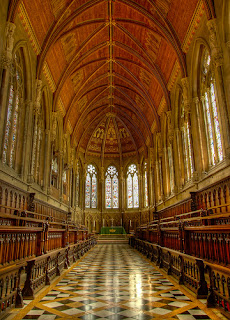el fumiero at the cathedral of saint james, compostela
'i am come that they might have life, and that they might have it more abundantly.' (jesus of nazareth)
life is more abundant at the edges, and more various, and more nourishing. there one finds the live that is low on the food chain, that sustains the other life that sometimes seems much more 'important.' (we were reminded of this often-over looked fact, over looked by us who think we find life in saran-wrapped packages at trader joe's, by last summer's oil spill in the gulf of mexico, one of the world's productive edges.) i knew this well when i was a hunter. the fence rows were where the game was. now the fence rows have been cut to make room for more wheat fields, but those wheat fields that fill the bags at trader joe's are at the edges of 'civilization' and beyond.
the same thing is true of life in the spirit. the lives that sustain the rest of us, or the portions of each of our lives that are sustaining, are at most often, most abundantly, at the edges. the shamans of the world live at the edges of their villages. moses, in the reading for the vigil of the feast of st. james, finds the holy one revealed not in egypt but in the wilds of midian, in a burning bush. the desert fathers follow the same tradition. and on the edges of the empire are to be found the places and practices that sustain us.
those who would 'rule' from the centers of the empire either don't understand the true nature of abundant life or try to ignore it. the irony of the eternal smoke that rises from babylon in the revelation to st. john (19:3) was lost on those who tried to build the roman papacy into a replacement for the roman caesaeracy. no matter. on the edges, in edessa and the thebiad, on the isles of glastonbury and lerins, there were places where the abundant life jesus had brought flourished. such a place, i suspect, was compostela, the pilgrimage site for st. james, at la finisterra, the end of the world.
spain would by the time of the 'renaissance' become more and more encumbered with papal relationships in her struggles against england and france, but for centuries she enjoyed being at the end of the earth. i suspect that she offered a european alternative to romanism, an alternative whose remainders are still visible today. mozarabic chant, the gallican rite, and the popularity of the pilgrimage to santiago, the cockle shell pilgrimage, all remind us of the abundance of life that flourished in the spanish church.
there is a tendency to explain some of the varied life of the spanish church by the long period of islamic rule. but the variations predate the islamic invasion, and are connected to many other strands of the life of the church outside the roman tapestry. the
legend of st.james, with its complicated story of the voyage of the relics of the apostle to a creek at the end of the world, covers as much as it uncovers. the celtic church made much of being the church of st. john. what we easily forget is that st. james the brother, the other of the three who were constantly with jesus, also probably carried the same traditions to spain that the irish cherished in britain.
this year, therefore, i suggest we look at the feast of st. james the greater as a celebration of life in its abundance, of the practices of the church that include the acts not just of the apostles and their successors (and of those who would claim to be their successors), but all the wonderful folk acts, the acts of the abuelas, the acts of the rustic pilgrims who made and still make the pilgrimage to the end of the world, where the largest dispenser of smoke in the world, the great
botafumiero at the end of the journey, and remember that the holy one is most often found not in blazing lights, but in clouds of streaming glory.


























